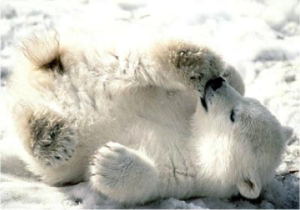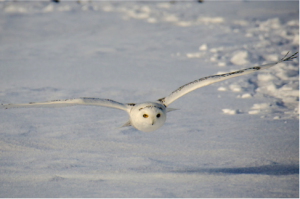When the temperature drops and the snow starts to fall, what kind of clothes do you need to put on to go outside? You need a coat, snow pants, a hat, mittens, wool socks, boots, and a scarf. All of that clothing works to keep you warm and dry.
Did you know there are animals that have special adaptations for living in cold and snowy places? These animals don’t need a coat to stay warm and dry! Come with me to learn more about animals that live in the snow and cold.
Polar Bears
 Polar bears live in the arctic, that means the northern most part of the world. It is very icy and cold there and there is also plenty of ocean water Polar bears are excellent swimmers and live most of the time on the edges of ice. They are the biggest carnivores on land and unlike other bears they eat mostly other animals instead of vegetation like seeds and berries.
Polar bears live in the arctic, that means the northern most part of the world. It is very icy and cold there and there is also plenty of ocean water Polar bears are excellent swimmers and live most of the time on the edges of ice. They are the biggest carnivores on land and unlike other bears they eat mostly other animals instead of vegetation like seeds and berries.
Polar bears mainly eat seals, which have a lot of fat and gives the bears plenty of warmth and energy to survive in the cold. They also have very thick fur that even covers their feet and a layer of thick fat called blubber that keeps them warm.
Unlike other bears, polar bears don’t hibernate. Only the polar bears that are going to be moms hibernate. The rest spend all year hunting and eating.
Ringed Seals
Ringed seals live mostly in the icy cold waters in the arctic. They can move farther in from the edge of the ice than any other seal because they have the ability to make and keep breathing holes in the ice. They can use their flippers to scrape out the holes and keep them from freezing over.
How long can you hold your breath? Ringed seals can dive very deep and stay underwater for up to 45 minutes! This helps them find fish to eat and avoid polar bears, their number one predator. Seals come onto the shore only once a year to rest and have their babies.
Reindeer
Reindeer live in the arctic north, in Canada, Northern Europe and Russia. Reindeer is another name for caribou. There are many different types of reindeer that live all over the north. Both boy and girl reindeer have antlers. They loose their antlers every year and grow a new set in the spring.
Reindeer eat grass like many other deer, but in the winter they survive on lichen. Lichen is a special kind of plant that grows on rocks. Their hooves are hollow so they can use them as scoops to move snow and look for food in the winter.
Reindeer also grow a special coat of hair in the winter. This hair is hollow which makes it really good at insulating the reindeer from cold weather. It is kind of like a built in down coat.
Snowy Owl
 Snowy owls are the perfect color to blend in with their snowy habitats. They have white feathers with brown spots and bars. Even their legs and feet have feathers to help protect them from the cold. Snowy owls can be found in the arctic north, but they often migrate further south and can often be seen in the United States.
Snowy owls are the perfect color to blend in with their snowy habitats. They have white feathers with brown spots and bars. Even their legs and feet have feathers to help protect them from the cold. Snowy owls can be found in the arctic north, but they often migrate further south and can often be seen in the United States.
Unlike other birds that migrate when the seasons change and move north when the weather is warmer, snowy owls migrate when they need to find more food. Lemmings and other small rodents are their primary prey. When food runs short in the arctic tundra, snowy owls will come much farther south.
Other owls hunt and are active at night, but the snowy owl can be seen hunting during the day.
Emperor Penguin
Emperor penguins live in the very far south in Antartica. Most emperor penguins live on the ice that is attached to the continent rather than the land. Emperor penguins have a very special way to care for their eggs and chicks. Once the egg is laid, the dad holds it on his feet. He has a special flap of extra skin on his tummy that helps keep the egg warm. The dads hold the eggs for 4 months and don’t eat the whole time! They huddle in a big circle and move from back to front helping to keep each other warm. When the egg hatches, the mom comes back and takes over caring for the chick. Soon the chick is big enough and both the mom and dad can take turns finding food for the family.
Adapted for a Snowy Habitat
Life in the snow and cold can be very harsh and difficult, but there are plenty of animals that are really good at living in these tough places. They have adapted fur or hair that can keep them warm; they can \ blend into their snowy surroundings and animals in snowy habitats have special ways of finding food in difficult arctic environments. What animals have you seen in the winter?
For more fun animal facts check out Jungle Jim’s fun songs!
Sources
“Fact Sheet: Polar Bears” Defenders of Wildlife
“Ringed Seals” National Geographic
“Caribou” National Geographic Kids
“Emperor Penguins Facts” Cool Antartica
